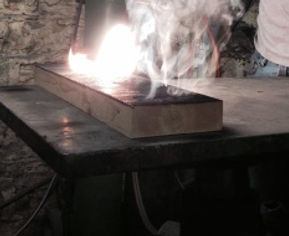Prototyping as a Tool // Matt Cadle
5/6/2014
By looking at the final product it’s hard to grasp all the processes that were needed to produce it. To construct the Florence Duomo, Brunelleschi designed a system of counterweights to lift the materials to a height that, at that time, was unprecedented. Prototyping is a similar process; an individual cannot see the importance from glancing at the final product, but is integral to reaching the solution. The Duomo’s counterweights, however; may not be the best comparison because they were a means to an end. Prototyping is not the execution of the design, it is part of the creative process allowing the designer to expand their knowledge and test ideas. Upon this experimentation, the flaws of ideas will become evident and, in moving forward, steps can be taken to improve the design. Designing is never a linear experience, in which you have an idea, put it on paper, then carry it out. Rather it is a circular process, your idea is drawn up, tried out, reconsidered, and reworked. Prototyping serves to link together the idea and its material consequences, providing the designer with knowledge that would otherwise be unattainable.


Experimentation is a way of to safeguarding creative freedom. It is a way to break away from allowing a designer’s limited knowledge of functional detailing to dictate the results. Instead, initially the idea becomes the driving force behind how the product is designed, thus allowing the designer to conceive a product that better serves its users. Intentions can be made to use a material, a construction technique, or an architectural element in an unusual way that provides a more practical or aesthetically pleasing result. These methods require testing and these tests become an iterative process jumping back and forth from designing for the needs of the user, to designing based on the capabilities of the material. By studying the design and allowing both material and conceptional ideas influence it, the product can provide the best mixture of user practically and durability.


As a member of the 7540 Washington Community furniture project, this team experimented with unique seating and cabinetry details. Mobile seating provided mixed seating types designed as a holistic unit looking to capture comfortable lounging and practical workspace. The cabinetry acted as the facilitator of the programmatic uses to the community room. Both designs entailed unknown material capabilities and were prototyped. The cabinets used a system of all thread that was used to hang the cabinets from a beam spanning from one wall in the community room to another wall. The omission of columns and the hanging of the cabinetry gave the system sense of floating. Aesthetics drove this design decision, however; we were unsure if the hanging system would be capable of holding the weight of its contents. The seating was to be constructed out of wood and steel. The frame capitalized on the strength of steel and wood was used as an affordable and durable means to construct a frame for soft seating. Although the detailing between the wood and steel was no easy task, the detailed that raised the most questions was a cantilevered stool welded to the back of the frame. Our team members were skeptical on how much weight it would be able to support and if the detail would comprise the stability of the unit as a whole.


The process of making these objects allowed us to view the project through a different lens. As we began to prototype these details, we began to realize easier methods to execute them. Issues that were not apparent on the computer screen became obvious as we began working with real material constraints. Through prototyping, the team was on our way to finding solutions to these unique design details. Unfortunately, funding for the project fell through, and we were unable to continue on our path of exploration and execution, however, the process we went through provided insights to our design that couldn’t have been obtained through other methods. Without utilizing the process of prototyping, we would not have been able to hold on to the conceptional ideas that supported and facilitated the envisioned programmatic uses of the community room.

Written by Matt Cadle
